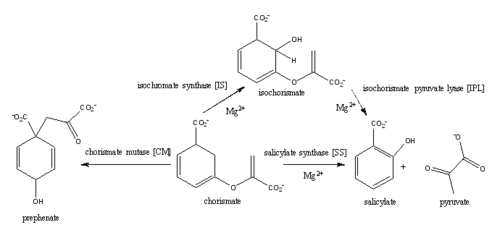Sandbox Reserved 1068
From Proteopedia
(Difference between revisions)
| Line 6: | Line 6: | ||
==Introduction== | ==Introduction== | ||
| - | Salicylate synthase from ''Mycobacterim tuberculosis'' (MtbI) is a highly promiscuous enzyme that has four distinct activities ''in vivo'': isochorismate synthase (IS), isochorismate pyruvate lyase (IPL), salicylate synthase (SS) and chromate mutate (CM). MtbI belongs to the chorismate-utilising enzyme family, which consists of structural homologues (<scene name='69/694235/Irp9/2'>Ipr9</scene>, <scene name='69/694235/Menf/2'>MenF</scene>, <scene name='69/694235/Entc/2'>EntC</scene>, and <scene name='69/694235/Mbti/2'>MbtI</scene>) that isomerize chromate to isochorismate. These enzymes are present in bacteria, fungi, plants and apicomplexan parasites and catalyze the initial reactions of menaquinone, siderophore, and tryptophan biosynthesis. The IS, IPL, and SS activity of MbtI require the presence of a magnesium ion within the active site, while CM activity is only observed in absence of the magnesium cation. IS, IPL, and SS activity are also modulated by the pH of the medium. Isochorismate is the primary product at pH values below 7.5 and salicylate is the primary product formed at pH 8. The pH dependent activity of MbtI is related to the ionization state of the active site residues involved in the molecular mechanisms used by the enzyme to catalyze the different reactions<ref>PMID:23108268</ref>. | + | Salicylate synthase from ''Mycobacterim tuberculosis'' (MtbI) is a highly promiscuous enzyme that has four distinct activities ''in vivo'': isochorismate synthase (IS), isochorismate pyruvate lyase (IPL), salicylate synthase (SS) and chromate mutate (CM). MtbI belongs to the chorismate-utilising enzyme family, which consists of structural homologues (<scene name='69/694235/Irp9/2'>Ipr9</scene>, <scene name='69/694235/Menf/2'>MenF</scene>, <scene name='69/694235/Entc/2'>EntC</scene>, and <scene name='69/694235/Mbti/2'>MbtI</scene>) that isomerize chromate to isochorismate. These enzymes are present in bacteria, fungi, plants and apicomplexan parasites and catalyze the initial reactions of menaquinone, siderophore, and tryptophan biosynthesis. The IS, IPL, and SS activity of MbtI require the presence of a magnesium ion within the active site, while CM activity is only observed in absence of the magnesium cation. IS, IPL, and SS activity are also modulated by the pH of the medium. Isochorismate is the primary product at pH values below 7.5 and salicylate is the primary product formed at pH 8. The pH dependent activity of MbtI is related to the ionization state of the active site residues involved in the molecular mechanisms used by the enzyme to catalyze the different reactions<ref name = "manos-turvey">PMID:23108268</ref>. |
The salicylate synthase activity of MbtI catalyzes the first committed step in the synthesis of the iron chelating siderophore, mycobactin, in ''Mycobacterium tuberculosis''(Figure 3)<ref name= "gamma chi">PMID:22607697</ref>. This complex secondary metabolite is essential for both virulence and survival of ''M. tuberculosis''. Therefore, inhibitors of salicylate synthase may serve as potential TB therapies with a novel mode of action. | The salicylate synthase activity of MbtI catalyzes the first committed step in the synthesis of the iron chelating siderophore, mycobactin, in ''Mycobacterium tuberculosis''(Figure 3)<ref name= "gamma chi">PMID:22607697</ref>. This complex secondary metabolite is essential for both virulence and survival of ''M. tuberculosis''. Therefore, inhibitors of salicylate synthase may serve as potential TB therapies with a novel mode of action. | ||
Revision as of 06:55, 11 April 2015
| This Sandbox is Reserved from 02/09/2015, through 05/31/2016 for use in the course "CH462: Biochemistry 2" taught by Geoffrey C. Hoops at the Butler University. This reservation includes Sandbox Reserved 1051 through Sandbox Reserved 1080. |
To get started:
More help: Help:Editing |
Mycobacterium tuberculosis salicylate synthase (Mbt1)
| |||||||||||
References
- ↑ Hanson, R. M., Prilusky, J., Renjian, Z., Nakane, T. and Sussman, J. L. (2013), JSmol and the Next-Generation Web-Based Representation of 3D Molecular Structure as Applied to Proteopedia. Isr. J. Chem., 53:207-216. doi:http://dx.doi.org/10.1002/ijch.201300024
- ↑ Herraez A. Biomolecules in the computer: Jmol to the rescue. Biochem Mol Biol Educ. 2006 Jul;34(4):255-61. doi: 10.1002/bmb.2006.494034042644. PMID:21638687 doi:10.1002/bmb.2006.494034042644
- ↑ Manos-Turvey A, Cergol KM, Salam NK, Bulloch EM, Chi G, Pang A, Britton WJ, West NP, Baker EN, Lott JS, Payne RJ. Synthesis and evaluation of M. tuberculosis salicylate synthase (MbtI) inhibitors designed to probe plasticity in the active site. Org Biomol Chem. 2012 Dec 14;10(46):9223-36. doi: 10.1039/c2ob26736e. Epub 2012, Oct 29. PMID:23108268 doi:http://dx.doi.org/10.1039/c2ob26736e
- ↑ 4.0 4.1 4.2 4.3 Chi G, Manos-Turvey A, O'Connor PD, Johnston JM, Evans GL, Baker EN, Payne RJ, Lott JS, Bulloch EM. Implications of Binding Mode and Active Site Flexibility for Inhibitor Potency against the Salicylate Synthase from Mycobacterium tuberculosis. Biochemistry. 2012 Jun 7. PMID:22607697 doi:10.1021/bi3002067
- ↑ Tuberculosis (TB). Ed. Sam Posner. Centers for Disease Control and Prevention, n.d. Web. 9 Apr. 2015.
- ↑ De Voss, James J., Kerry Rutter, Benjamin G. Schroeder, Hua Su, and YaQi Zhu. The salicylate-derived mycobacterium siderophore of Mycobacterium tuberculosis are essential for growth in macrophages. "Proceedings of the National Science Academy" 97.3 (2000): 1252-57. Web. 5 Apr. 2015.
- ↑ He Z, Stigers Lavoie KD, Bartlett PA, Toney MD. Conservation of mechanism in three chorismate-utilizing enzymes. J Am Chem Soc. 2004 Mar 3;126(8):2378-85. PMID:14982443 doi:http://dx.doi.org/10.1021/ja0389927


